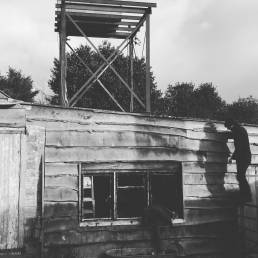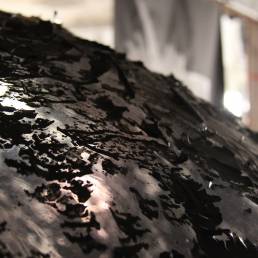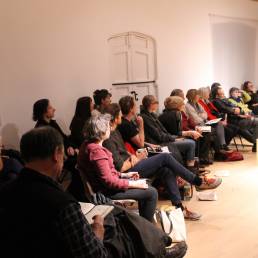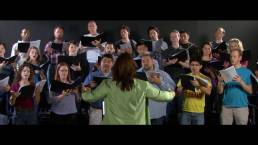
‘The Golden Space City of God’
Richard Grayson – The Golden Space City of God
24 January – 9 February 2014
The Golden Space City of God by Richard Grayson, the first solo exhibition to be held at the OSR Project Space by a major international artist, is a large-scale video installation with sound featuring a choral work performed by a 26 piece choir. The installation gives the impression of a space linked to community expression and exchange, a church or community hall. This has a heightened resonance in the context of the OSR Project Space, formerly known as the Old School Room, built in 1850 and used as a school for only 26 years before becoming the unofficial community hall for the village of West Coker.
The Golden Space City of God score was composed by Leo Chadburn based on a libretto by the artist – which appears as subtitles in the video work –abstracted from a website associated with The Family, a community that developed from the 1960’s cult Children of God. It is based upon texts that give a detailed prediction of events leading up to the end of the world, drawn from the Book of Revelation and re-imagined through the languages and imagery of science fiction. They describe the widespread economic and social unrest that will spread across the globe following an oil crisis and the collapse of Dollar-based economies. Out of this chaos a leader emerges, assisted by UFOs, who establishes a worldwide government through his use of credit and barcode technologies, UNESCO and the European Economic Community…
He builds a robot and Capitalism is abolished;
Jesus returns to Earth to fight against his empire and establish a kingdom of the saved;
A thousand years pass where survivors live in an ideal society based on an agrarian economy of exchange, and the elect – who have been given new supernatural indestructible bodies – rule over the rest of humankind, using the power of invisibility to place them effectively;
The masses rise again only to be defeated by fire and plague and God descends in the biggest space ship ever built, the Golden Space City, to take the elect away to explore and colonise new planets and galaxies…
The Golden Space City of God was filmed and recorded at Say Si in San Antonio, Texas on Saturday 14 March 2009 and was commissioned and produced by Artpace, San Antonio and Matt’s Gallery London.
Born 1958 Morecambe, England
Richard Grayson is an artist, writer and curator. He was a founder member of The Basement Group and director of the Experimental Art Foundation, Australia, 1991-98. He curated the Sydney Biennale. He is currently Bartlett research Fellow in the Department of Arts and Cultures, University of Newcastle.
Richard Grayson’s work as an artist investigates how language and narrative are used to make sense of the world around us, and how in turn these narratives generate worlds of their own. Subjective personal readings and constructions of the world and the ways that these achieve social political and cultural function is the focus of his work.
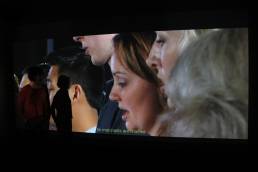
Review by Bob Gelsthorpe
Driving through Somerset, on the way to the gallery, there is a worry of the car becoming stuck in what I anticipate to be a quagmire, following on from the horrendous weather. Upon reaching West Coker the warm and inviting greeting from the cheery gallery director belittles such thoughts. Nothing outlandish to distinguish the gallery from the surrounding village cottages/house aesthetic channeling familiarity that is easy to access. This Old School Room has houses OSR Projects naturally attracts a resonance with the choral, which we later find to compliment the curatorial direction of the programme.
The first solo show of their programme, this is the fourth solo showing of The Golden Space City of God by British Artist/Curator/Writer, Richard Grayson; firstly showing at the UK’s first artist-led, Matt’s Gallery, London, but the very architecture of the space, the arched roof with large wooden beams resonates the atmosphere of the community hall, beckoning the possibility that this could of very much been the first showing. Plastic stacking chairs, a very welcoming gallery dog, blacked out space and a carpet lent from Arnolfini create a first contact tension between the choral rehearsal space and cinema settings that sets up the politics of the installation.
The single channel video installation has an initial cinematography that is straightforward, with a distinction between the performers and the audience; the conductor has their back towards the camera, intent on choreographing the performance perfectly. I sit in the space, front row, absorbing the performance as though it were live.
The sung words are subtitled in a seductive fading of gold, linking straight to the title, and the Libretto abstracted from a website dedicated to The Children of God, also called The Family, a South-California 1960’s cult (as described by John Huxley) that forms the lyric of the installation. These words are to be absorbed in their fullest, as script, as text and as warning (this satirical text is not to be taken lightly as the organization unfortunately still exists and operates) in the first movement: The Arrival of the Antichrist, full of vivid dystopic imagery that takes a while to adjust, as not your conventional text for a choir.
There is a disciplined stillness from the performers, bringing to mind Sonia Boyce’s For You, Only You (2007)project with Mikhail Karikis, Alamire choir & David Bickerstaff, the role of Mikhail as the active viewer, and David Skinner (conductor) as the passive, instructor, creating an interesting relationship, or perhaps even power play within the performance. Within The Golden Space City Of God, the audience adopts an aspect of the performing Karikis in For You, Only You: engaged, excited, but in sporadic bursts. By the time of the third movement; The Statue, the cinematics have become more dramatic, focusing more on the conductor, maintaining command, yet still unidentified. The third movement of the Libretto carries some fantastic imagery of ‘sub-skin PIN 666-Chip-Implants’, bubbling up Blade Runner (1982) fantasies of detection and subversion within a world in inevitable demise.
The fifth movement, The Tribulation, has an unavoidable clearness of subtle nuances in the cinematic direction that makes Grayson such a treasured artist, there is a build up, assuming to mimic a crescendo, but after the third and fourth viewing of the piece, is an effective scaling up in the performance, facilitating a slight empathy. A connection with the choir at this point has been established, their eyes darting between conductor and lyrics engrossed in the movement. “…Three and a half years…”, over and over again these three and a half lunar years serve a ritualistic purpose but leave enough ambiguousness to keep mentally searching for meaning. A constant urge to ground it, to place it within the tangible is built up, and simply left floating, a natural human desire to make sense of the senseless overrides. These cinematic and choral devices are pulled to the front, as the focusing in and out of the installation is natural over its long duration.
A glimpse of the conductors face and a few shots of the bleachers that the choir stand on shows Grayson’s deep interest in the choir as sculpture through video, exploring these viewpoints, we consider some of the performative and sculptural qualities of a choir, its collaborative aspect that seems to champion the qualities of the entire project. If we take Don DeLillo’s White Noise (1985) into consideration, “Maybe there is no death as we know it, just documents changing hands”; it provides a context for the role of authorship within Grayson’s installation if we abstract ideas in DeLillo’s novel that deal with demise and humanities natural avoidance and failure to accept death through the modern middle American family. In his previous work, Messiah (2004), we can see some of the earlier stages of this abstraction of text and use of choral activity. Again looking at collaborative practice in regards to authorship within choral contemporary video art, in Bethan Huws’ project with The Bistritsa Babi, A Work for the North Sea (1993) she discusses in conversation with James Lingwood in 2004, “It was an important part of the work that these were Bulgarians and that they were singing in England – the displacement – where none of us in the audience would understand the meaning of their words. And yet we stay to listen to them as abstract sound or pure sense with much less meaning”. This relates to the conundrum that was faced while trying to ground the total absurdity of the psudo-scripture text, we can take it as abstract sound shapes, formed in a lyrical manner or as a sensibility of the cult, Children of God.
The collaborative authorship within The Golden Space City of God is indeed a potentially constant source of research, development, rehearsal, collaboration and documents forever changing hands, rendering me thankful that Grayson not only explores his practice as an artist, but through his writings and curatorial projects. By the ninth and tenth (and final) movements, the narrative has finished condemning and ends with colourful, absurd prophecies of The Golden Space City descending and welcoming, ‘all the saved of all ages’, their ‘UFO’ a 1,500 mile cube. The choir finish and the conductor rests in the fixed position shot that they began in, bringing the piece full circle, providing a closure on the narrative, and a closing on the piece.
Review By Scoop Malloy for Yeovil Live
Struggling with post-Xmas malaise? Still sick of the sight of turkey? Has the diet failed? Are you back on the fags? Well, take heart – there’s a new exhibition presented by Simon Lee Dicker at the OSR Project Space in West Coker to bolster the spirit.
The Golden Space City of God is a filmed choral work by Richard Grayson and is projected on to the back wall of the gallery. Speakers and chairs are all positioned precisely to the artist’s instructions thus creating a complete environment. The installation is aided and abetted by the audience who either sit as silently as the creaky chairs will allow for the 45 minute duration of the piece or move in and out at will. The libretto is concerned with the ecological and technological breakdown of society, the dominance of Satan and the eventual return of Christ and is derived from the beliefs of the the cult known as the Children of God. It’s a choral Book of Revelations, a prophecy in song. But it ends on an uplifting note with the return of God in his golden spaceship and a Utopian existence for mankind. All good and positive stuff for the new year.
For those of you who are not inclined to appreciate the delights of gazing at huge choristers heads projected in HD then there is a small gallery adjoining the exhibition space where a couple of drawings by the artist are on display.
It’s unlikely that Simon will be curating any further exhibitions at the OSR Project Space until the autumn so this will be your last chance for a while to experience something new and challenging in the Yeovil area. Drop in and pay him a visit.
Scoop Malloy
